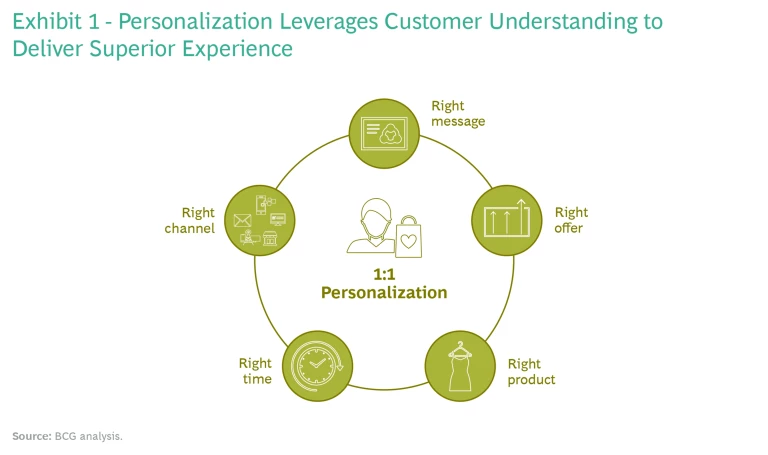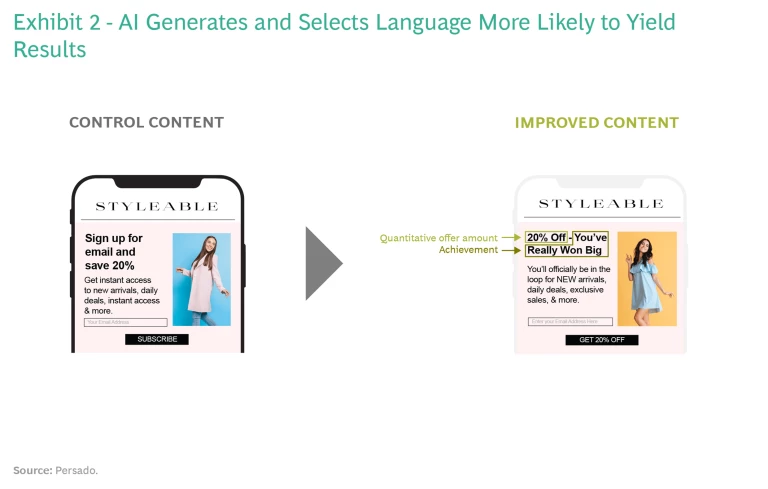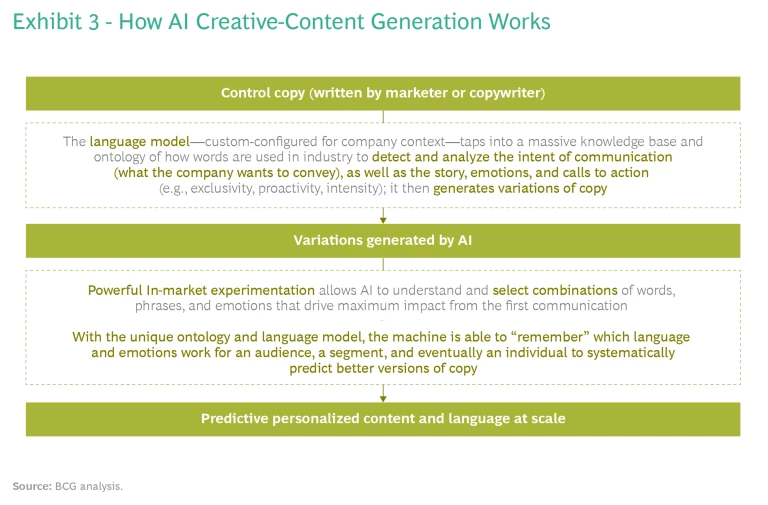Companies looking to make a step change in customer and consumer engagement should investigate this powerful new technology now.
This article was written in collaboration with Persado, an advanced personalization platform that fuses AI-generated creative content with a sophisticated decision engine.
A major new force is taking shape in personalization, one that could generate as much as $200 billion in incremental revenue for the Fortune 500 and up to $800 billion worldwide over the coming decade. The combination of AI-generated creative content and AI-unlocked decision making that matches content with the intended recipient at scale, is already showing impressive results across a broad spectrum of industries. Others will want to investigate this new capability before they find themselves losing sales and share to more advanced competitors.
Consumer and customer engagement today is more and more about personalization. BCG research in 2020 found that the number-one goal for digital transformations , cited by nine out of ten executives, is customer centricity and personalization. A similar share of the executives we interviewed for this article sounded a similar theme. “Customer centricity is our motto,” one said. “You need to be very personalized to win customers over.”
The ability of companies to personalize customer relationships at scale keeps getting better, more automated, and more, well, personal. We wrote in February 2021 about how the combination of data, advanced analytics, and new content and media can unlock the potential of personalized content at the point of interaction—delivering individually relevant content at scale . Leaders are now using AI-driven technology that enables both content generation and content matching to automate and shape how companies communicate with customers in a more one-to-one way than ever.
Automatically Personalized
The basic framework of personalization is well-known: delivering the right product at the right price to the right person through the right channel at the right time. (See Exhibit 1.) Consumer-facing companies have refined most of the steps in this process over the last few years, but little attention has been paid to choosing the specific words that will inspire the recipient of a message to take action—or to identifying such words automatically. On the journey to true personalization, mapping words to the emotional responses and verbal preferences of individual subjects has been the most difficult thing to get right, and thus has remained a largely unautomated (and unscientific) endeavor.
The AI-powered capability rapidly entering the mainstream—which we call AI creative-content generation—changes that with algorithms married to massive databases of tagged words and phrases. At each point of customer interaction, the technology strives to choose the words and phrases that will resonate most powerfully and to match the most effective combinations with their intended recipients. Automating both the content generation and the targeting of individual messages represents a step change in personalized marketing.
Results show that this combination can drive massive incremental value. Drawing on millions of tagged and scored words and phrases, along with natural-language generation and experimental design, algorithms generate greater certainty and precision, delivering an average increase in conversion rates of more than 40% across engagement channels along the customer journey .
For example, a large retailer was experiencing declining engagement with its pop-up web-advertising copy, leading to reduced acquisition of high-quality customers and reduced sales from new visitors. The problem was also compromising the company’s ability to derive the insights needed to create personalized messaging. Using Persado’s platform, the retailer achieved a 127% increase in revenue, a 112% uplift in orders, and 103% more new-shopper sign-ups. Moreover, it was able to confirm that the use of achievement-oriented language in its ads—"You’ve really won big”—was the single biggest driver of new subscribers. (See Exhibit 2.)
For companies already far up the personalization maturity curve, this is an opportunity for further advancement in how they communicate with consumers. For those at an earlier point in the journey, the technology offers a chance to leapfrog basic capabilities and achieve much more sophisticated enterprise-wide personalization at scale.
While AI creative-content generation is still relatively new, use cases are expanding fast and the technology is gaining traction quickly. Sophisticated, data-driven Fortune 100 companies have already realized significant value, and many others see it as a top priority for trial and experimentation going forward. Industries from retail to financial services to travel to insurance are leveraging the technology. Use cases span enterprise-wide customer interactions and communications, including marketing (awareness, customer acquisition, onboarding, retention and loyalty, and life cycle management), e-commerce (product descriptions and landing pages), and customer service (service-driven sales, chatbots, and interactive voice response). AI creative content is seeing significant success in every channel in which short sequences of words are used to motivate people to action, including SMS, email, website and push marketing, and more.
Potential uses outside the corporate sector include government public-service announcements and fundraising efforts for nonprofits. We also see potential for the technology to expand into direct-to-consumer applications, including social networking, dating profiles, and professional development.
AI in Action
Consider this example. A mobile telco wanted to encourage customers to upgrade their handsets. It designed a campaign with special offers on devices and service plans, including the option of receiving a new phone free for a trial period. The telco’s ad agency fashioned the associated words and phrases into copy that formed the basis of the campaign.
In a traditional campaign, this copy—developed using the copywriter’s intuition and experience—would be used consistently across the entire campaign; success would rest largely on a process driven by guesswork. AI creative-content generation vastly improves the precision of the endeavor, scientifically selecting the best words for every message. The algorithm takes the basic copy and breaks it down into its component parts (such as formatting, emotional appeal, and call to action) so that it can engineer how they work together for different user segments. Using an existing (and continuously expanding) database of words and phrases, the algorithm then generates all the possible permutations of the copy, which can run into the hundreds of thousands, or even millions, of options. Based on past campaign experience, it selects a manageable universe of, say, a dozen or two alternatives to test. In-market experimentation reveals the specific copy that is most effective in each channel—email, website ads, in-app offers, and the like—for different consumer segments.
AI creative-content generation is coupled with a robust, scientific, test-and-learn approach to the creative development process. The best variants of the campaign are rolled out and their performance rigorously measured to further train the machine-learning engine for future use. In this way, AI augments human copywriters’ ability to make optimal decisions at scale. (See Exhibit 3.)
With AI creative-content generation, the mobile phone company’s campaign generated a 36% increase in engagement and an 83% increase in conversions compared with a control group using a traditional campaign. Further, it was able to explain why the AI-generated messages were more effective, ascribing the engagement lift to three key elements: emotional appeal (69%), positioning (14%), and call to action (17%).
In similar fashion, a major US bank and airline teamed up to market a new affinity credit card. Key to this campaign was the deployment of AI creative-content generation to the entire customer base and messaging tailored to three different customer segments. The companies’ decision-making platform looked at customers in primary hub cities, secondary hub cities, and nonhub cities and deployed the AI-driven algorithm to pinpoint the copy that resonated most strongly with each. They quickly found that customers in primary hub cities, for example, had the strongest reaction to appeals offering a free checked bag and club passes, while those in secondary hubs were most motivated by complimentary benefits and earned miles with no expiration date. Club passes and free checked bags worked best with nonhub customers (but in reverse order of priority compared with primary hub customers). As a result of this personalized, segment-specific messaging, the bank and airline were able to achieve a 29% to 61% reduction in cost per acquisition for the three segments.
Time to Move
As software companies render this future more achievable , we expect interest and use to continue to expand quickly. The size, depth, and quality of each vendor’s existing language database are important factors for consumer-focused executives to consider, since a large language knowledge base of millions of tagged words and phrases is difficult and time-intensive to build. But because AI learns and improves as it works, early movers have the advantage of supplying context-specific knowledge to the algorithm sooner. This is true even when multiple companies work with the same platform provider.
Companies looking to partner with best-in-class suppliers will want to move right away. They can leverage the significant expertise that has already been developed, but while the technology is plug and play, it improves with specialization—requiring knowledge and experience on the part of users as well as vendors. Companies will need to train personnel and establish processes for content development, campaign execution, and experimentation and adjustment.
The combination of AI creative-content generation and superior decision-making platforms is already establishing the next stage in personalization . Companies looking to make a step change in enterprise-wide customer and consumer engagement should investigate this powerful new technology now.













